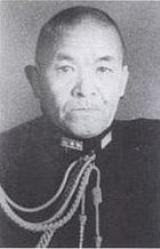
Attack on Pearl Harbor order of battle
Encyclopedia
This is the attack on Pearl Harbor
's order of battle
for both the Empire of Japan
and the United States
.
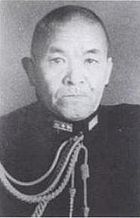
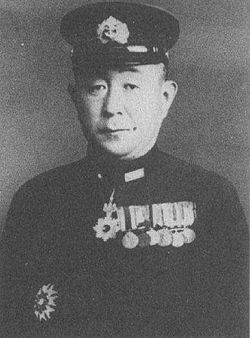

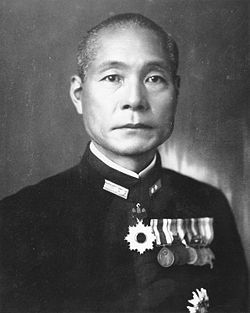


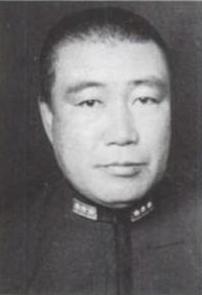

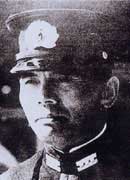
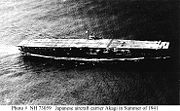


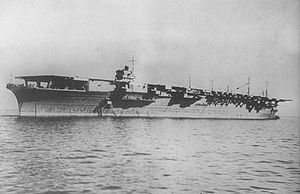

 Naval General Staff—Admiral Osami Nagano
Naval General Staff—Admiral Osami Nagano
}
}
}
} (patrolling Channel entrance to Pearl Harbor)
}
}
}
}
}
}
}
}
}
}
}
}
}
}
}
}
}
}
}
}
}
}
}
}
}
}
}
}
}
}
}
}
}
}
}
}
}
}
}
}
}
}
}
}
}
} (at Honolulu)
}
} (entering Pearl Harbor)
}
}
} (entering Pearl Harbor)
} (12 nautical miles (22.2 km) outside Pearl Harbor entrance)
} (Target ship)
}
}
} (out of commission)
Attack on Pearl Harbor
The attack on Pearl Harbor was a surprise military strike conducted by the Imperial Japanese Navy against the United States naval base at Pearl Harbor, Hawaii, on the morning of December 7, 1941...
's order of battle
Order of battle
In modern use, the order of battle is the identification, command structure, strength, and disposition of personnel, equipment, and units of an armed force participating in field operations. Various abbreviations are in use, including OOB, O/B, or OB, while ORBAT remains the most common in the...
for both the Empire of Japan
Empire of Japan
The Empire of Japan is the name of the state of Japan that existed from the Meiji Restoration on 3 January 1868 to the enactment of the post-World War II Constitution of...
and the United States
United States
The United States of America is a federal constitutional republic comprising fifty states and a federal district...
.
Imperial Japanese Navy















- Combined FleetCombined FleetThe was the main ocean-going component of the Imperial Japanese Navy. The Combined Fleet was not a standing force, but a temporary force formed for the duration of a conflict or major naval maneuvers from various units normally under separate commands in peacetime....
- Admiral Isoroku YamamotoIsoroku Yamamotowas a Japanese Naval Marshal General and the commander-in-chief of the Combined Fleet during World War II, a graduate of the Imperial Japanese Naval Academy and a student of Harvard University ....
- Admiral Isoroku Yamamoto
- First Air Fleet1st Air Fleet of the Imperial Japanese NavyThe Imperial Japanese Navy at the beginning of World War II contained the world's largest carrier fleet. At the centre, was the 1st Air Fleet which was a grouping of naval aircraft and aircraft carriers...
- Vice Admiral Chuichi NagumoChuichi Nagumowas a Japanese admiral in the Imperial Japanese Navy during World War II and one time commander of the Kido Butai . He committed suicide during the Battle of Saipan.-Early life:...
- Vice Admiral Chuichi Nagumo
- 1st Carrier Division
- Vice Admiral Nagumo
- AkagiJapanese aircraft carrier AkagiAkagi was an aircraft carrier of the Imperial Japanese Navy , originally begun as an . She was converted while still under construction to an aircraft carrier under the terms of the Washington Naval Treaty...
(flagFlagshipA flagship is a vessel used by the commanding officer of a group of naval ships, reflecting the custom of its commander, characteristically a flag officer, flying a distinguishing flag...
)—Captain Kiichi HasegawaKiichi Hasegawa-Notes:...
- Air Officer—Commander Masuda Shogo
- VTB Leader—Commander Mitsuo FuchidaMitsuo Fuchidawas a Japanese Captain in the Imperial Japanese Navy Air Service and a bomber pilot in the Imperial Japanese Navy before and during World War II. He is perhaps best known for leading the first air wave attacks on Pearl Harbor on 7 December 1941...
- 1st Squadron (5x B5N2 "Kate"Nakajima B5N|-See also:-References:NotesBibliography* Bridgwater, H.C. and Peter Scott. Combat Colours Number 4: Pearl Harbor and Beyond, December 1941 to May 1942. Luton, Bedfordshire, UK: Guideline Publications, 2001. ISBN 0-9539040-6-7....
)—Commander Fuchida - 2nd Squadron (5xB5N)-Lieutenant Iwasaki Goro
- 3rd Squadron (5xB5N)-Lieutenant Furukawa Izumi
- 1st Squadron (5x B5N2 "Kate"
- VT Leader—Lieutenant Commander Murata Shigeharu
- 1st Squadron (3xB5N)-Lieutenant Commander Shigehara
- 2nd Squadron (3xB5N)
- 3rd Squadron (3xB5N)-Lieutenant Negishi Asao
- 4th Squadron (3xB5N)
- VB Leader—Lieutenant Takehiko Chihaya
- 21st Squadron (3xD3A1 "Val"Aichi D3AThe , Allied reporting name "Val") was a World War II carrier-borne dive bomber of the Imperial Japanese Navy . It was the primary dive bomber in the Imperial Japanese Navy, and participated in almost all actions, including Pearl Harbor....
)—Lieutenant Chihaya - 22nd Squadron (3xD3A) (1 aircraft lost)
- 23rd Squadron (3xD3A) (1 aircraft lost)
- 25th Squadron (3xD3A)-Lieutenant Zenji Abe
- 26th Squadron (3xD3A) (2 aircraft lost)
- 27th Squadron (3xD3A)
- 21st Squadron (3xD3A1 "Val"
- VF Leader—Lieutenant Commander Shigeru Itaya
- 1st FCU Wave 1 (9xA6M2 "Zeke"A6M ZeroThe Mitsubishi A6M Zero was a long-range fighter aircraft operated by the Imperial Japanese Navy Air Service from 1940 to 1945. The A6M was designated as the , and also designated as the Mitsubishi A6M Rei-sen and Mitsubishi Navy 12-shi Carrier Fighter. The A6M was usually referred to by the...
)—Lieutenant Commander Itaya (one aircraft lost) - 1st FCU Wave 2 (9xA6M)—Lieutanant Saburo Shindo
- CAP (9xA6M)
- 1st FCU Wave 1 (9xA6M2 "Zeke"
- VTB Leader—Commander Mitsuo Fuchida
- Air Officer—Commander Masuda Shogo
- KagaJapanese aircraft carrier KagaKaga was an aircraft carrier of the Imperial Japanese Navy , named after the former Kaga Province in present-day Ishikawa Prefecture...
—Captain Okada Jisaku- Air Officer—Commander Sata Naohito
- VTB Leader--Lieutenant Commander Kakuichi Hashiguchi
- 1st Sqdn (5xB5N)—Lieutenant Commander Hashiguchi
- 2nd Squadron (5xB5N)-Lieutenant Hideo Maki
- 3rd Squadron (5xB5N)-Lieutenant Yoshitaka Mikami
- VT Leader—Lieutenant Kazuyoshi Kitajima
- 1st Squadron (3xB5N)—Lieutenant Kitajima (one aircraft lost)
- 2nd Squadron (3xB5N) (one aircraft lost)
- 3rd Squadron (3xB5N)-Lieutenant Mimori Suzuki (Killed in ActionKilled in actionKilled in action is a casualty classification generally used by militaries to describe the deaths of their own forces at the hands of hostile forces. The United States Department of Defense, for example, says that those declared KIA need not have fired their weapons but have been killed due to...
) (two aircraft lost) - 4th Squadron (3xB5N) (one aircraft lost)
- VB Leader—Lieutenant Saburo Makino (Killed in ActionKilled in actionKilled in action is a casualty classification generally used by militaries to describe the deaths of their own forces at the hands of hostile forces. The United States Department of Defense, for example, says that those declared KIA need not have fired their weapons but have been killed due to...
)- 21st Squadron (3 D3A)—Lieutenant Makino (one aircraft lost)
- 22nd Squadron (3 D3A)
- 23rd Squadron (3 D3A) (one aircraft lost)
- 24th Squadron (3 D3A)-Lieutenant Shoichi Ogawa (two aircraft lost)
- 25th Squadron (3 D3A)
- 26th Squadron (3 D3A)
- 27th Squadron (3 D3A)-Lieutenant Shoichi Ibuki (one aircraft lost)
- 28th Squadron (3 D3A) (one aircraft lost)
- 29th Squadron (3 D3A)
- VF Leader—Lieutenant Yoshio ShigaYoshio Shigawas an officer, ace fighter pilot, and leader in the Imperial Japanese Navy during the Second Sino-Japanese War and the Pacific theater of World War II. At the December 1941 Attack on Pearl Harbor, Shiga led one of the aircraft carrier Kaga's fighter divisions during the first strike on American...
- 2nd FCU Wave 1 (9xA6M)—Lieutenant Shiga
- 2nd FCU Wave 2 (9xA6M)—Lieutenant Yaushi Nikaido (two aircraft lost)
- CAP (9xA6M)
- VTB Leader--Lieutenant Commander Kakuichi Hashiguchi
- Air Officer—Commander Sata Naohito
-
- 7th Destroyer Division (Midway Attack Unit)
- UshioJapanese destroyer Ushiowas the twentieth of twenty-four destroyers, built for the Imperial Japanese Navy following World War I. When introduced into service, these ships were the most powerful destroyers in the world. They served as first-line destroyers through the 1930s, and remained formidable weapons systems well...
(FubukiFubuki class destroyerThe was a class of twenty four destroyers of the Imperial Japanese Navy. The Fubuki class has been called "the world's first modern destroyer." The Fubuki class not only set a new standard for Japanese vessels, but for destroyers around the world...
-class)- SazanamiJapanese destroyer Sazanamiwas the nineteenth of twenty-four s, built for the Imperial Japanese Navy following World War I. When introduced into service, these ships were the most powerful destroyers in the world...
(Fubuki-class)
- Sazanami
- Ushio
- 7th Destroyer Division (Midway Attack Unit)
- 2nd Carrier Division
- Rear Admiral Yamaguchi Tamon
- SōryūJapanese aircraft carrier Soryuwas an aircraft carrier of the Imperial Japanese Navy. During the Second World War, she took part in the attack on Pearl Harbor, Wake Island, Port Darwin and raids in the Indian Ocean before being sunk at the Battle of Midway.-Design:...
—Captain Yanagimoto RyusakuRyusaku Yanagimoto- Notes :...
- Air Officer—Commander Kusumoto Ikuto
- VTB Leader—Lieutanant Heijiro Abe
- 1st Squadron (5xB5N)—Lieutanant Abe
- 2nd Squadron (5xB5N)-Lieutenant Sadao Yamamoto
- VT Leader—Lieutenant Tsuyoshi Nagai
- 1st Squadron (2xB5N)—Lieutenant Nagai
- 2nd Squadron (2xB5N)
- 3rd Squadron (2xB5N)-Lieutenant Tatsumi Nakajima
- 4th Squadron (2xB5N)
- VB Leader—Lieutenant Commander Egusa Takeshige
- 21st Squadron (3xD3A)—Lieutenant Commander Egusa (one aircraft lost)
- 22nd Squadron (3xD3A)
- 23rd Squadron (3xD3A)
- 24th Squadron (3xD3A)-Lieutenant Masatake Ikeda
- 25th Squadron (3xD3A)
- 26th Squadron (3xD3A) (one aircraft lost)
- VF-Leader—Lieutenant Masaji Suganami
- 3rd FCU Wave 1 (9xA6M)—Lieutanant Suganami
- 3rd FCU Wave 2 (9xA6M)—Lieutenant Fusata Iida (Killed in ActionKilled in actionKilled in action is a casualty classification generally used by militaries to describe the deaths of their own forces at the hands of hostile forces. The United States Department of Defense, for example, says that those declared KIA need not have fired their weapons but have been killed due to...
) (three aircraft lost) - CAP (9xA6M)
- VTB Leader—Lieutanant Heijiro Abe
- HiryūJapanese aircraft carrier Hiryuwas a modified Sōryū-class aircraft carrier of the Imperial Japanese Navy. She was one of the carriers that began the Pacific War with the attack on Pearl Harbor...
—Captain Kaku Tomeo- Air Officer—Commander Amagai Takahisa
- VTB Leader—Lieutenant Commander Tadashi Kosumi
- 1st Squadron (5xB5N)—Lieutenant Commander Kosumi
- 2nd Squadron (5xB5N2 "Kate")-Lieutenant Toshio Hashimoto
- VT Leader—Lieutenant Heita Matsumura
- 1st Squadron (2xB5N)—Lieutenant Matsumura
- 2nd Squadron (2xB5N)
- 3rd Squadron (2xB5N)-Lieutenant Hiroharu Sumino
- 4th Squadron (2xB5N)
- VB Leader—Lieutenant Michio Kobayashi (not present)
- 21st Squadron (2xD3A)—Lieutenant Kobayashi
- 22nd Squadron (3xD3A) (one aircraft lost)
- 23rd Squadron (3xD3A)
- 24th Squadron (3xD3A)-Lieutenant Shun Nakagawa
- 25th Squadron (3xD3A)
- 26th Squadron (3xD3A) (one aircraft lost)
- VF Leader—Lieutenant Okajima
- 4th FCU Wave 1 (6xA6M)—Lieutenant Kiyokima Okajima
- 4th FCU Wave 2 (9xA6M)—Lieutenant Sumio Nono (one aircraft lost)
- CAP (9xA6M)
- VTB Leader—Lieutenant Commander Tadashi Kosumi
- Air Officer—Commander Amagai Takahisa
- 5th Carrier Division
- Rear Admiral Hara ChuichiChuichi Hara-External links:*...
- ShōkakuJapanese aircraft carrier ShokakuShōkaku was an aircraft carrier of the Imperial Japanese Navy, the lead ship of her class. Along with her sister ship , she took part in several key naval battles during the Pacific War, including the attack on Pearl Harbor, the Battle of the Coral Sea and the Battle of the Santa Cruz Islands...
(Shōkaku-class)—Captain Jojima Takatsugu - Air Officer—Commander Wada Tetsujiro
- VTB Leader—Lieutenant Tatsuo Ichihara
- 1st Sqdn (9xB5N)—Lieutenant Ichihara
- 2nd Squadron (9xB5N)-Lieutenant Tsutomu Hagiwara
- 3rd Squadron (9xB5N)-Lieutenant Yoshiaki Ikuin
- VB Leader—Lieutenant Commander Takahashi Kakuichi
- 1st Sqdn (9xD3A)—LCDR Takahashi
- 2nd Squadron (9xD3A)-Lieutenant Masao Yamaguchi (one aircraft lost)
- 3rd Squadron (9xD3A)-Lieutenant Hisayoshi Fujita
- VF Leader—Lieutenant Tadashi Kaneko
- 5th FCU Wave 1 (6xA6M)—Lieutenant Kaneko
- CAP (9xA6M)
- VTB Leader—Lieutenant Tatsuo Ichihara
- Rear Admiral Hara Chuichi
-
- ZuikakuJapanese aircraft carrier ZuikakuZuikaku was a Shōkaku-class aircraft carrier of the Imperial Japanese Navy. Her complement of aircraft took part in the attack on Pearl Harbor that formally brought the United States into the Pacific War, and she fought in several of the most important naval battles of the war, finally being sunk...
(Shōkaku-class)—Captain Yokokawa Ichibei - Air Officer—Commander Shimoda Hisao
- VTB Leader—Lieutenant Commander Shigekazu ShimazakiShigekazu Shimazaki, was a Japanese career officer in the Imperial Japanese Navy Air Service during World War II.-Biography:Shimazaki was a native of Ōita Prefecture and a graduate of the 57th class of the Imperial Japanese Navy Academy in 1929, ranking 31st of 122 cadets...
- 1st Squadron (9xB5N)—Lieutenant Commander Shimazaki
- 2nd Squadron (9xB5N)-Lieutenant Takemi Iwami
- 3rd Squadron (9xB5N)-Lieutenant Yoshiaki Tsubota
- VB Leader—Lieutenant Commander Sakamoto Akira
- 1st Squadron (9xD3A)—Lieutenant Commander Akira Sakamoto
- 2nd Squadron (9xD3A)-Lieutenant Tomatsu Ema
- 3rd Squadron (9xD3A) Lieutenant C. Hayashi
- VF Leader—Lieutenant Masao Sato
- 6th FCU Wave 1 (6xA6M)—Lieutenant Sato
- CAP (9xA6M)
- VTB Leader—Lieutenant Commander Shigekazu Shimazaki
- Zuikaku
- DD AkigumoJapanese destroyer AkigumoAkigumo was a Imperial Japanese Navy destroyer of the .Shortly after the Battle of the Santa Cruz Islands during the early hours of 27 October 1942, Akigumo along with the destroyer Makigumo sunk the heavily damaged and abandoned USS Hornet...
(Yugumo-class)
- 3rd Battleship Division
- Vice Admiral Mikawa Gunichi
- HieiJapanese battleship Hieiwas a warship of the Imperial Japanese Navy during World War I and World War II. Designed by British naval architect George Thurston, she was the second launched of four s, among the most heavily armed ships in any navy when built. Laid down in 1911 at the Yokosuka Naval Arsenal, Hiei was formally...
- KirishimaJapanese battleship Kirishimawas a warship of the Imperial Japanese Navy during World War I and World War II. Designed by British naval engineer George Thurston, she was the third launched of the four Kongō-class battlecruisers, among the most heavily armed ships in any navy when built...
- Hiei
- Vice Admiral Mikawa Gunichi
- 8th Cruiser Division
- Rear Admiral Abe HiroakiHiroaki Abewas an admiral in the Imperial Japanese Navy during World War II.-Early career:Abe was born in Yonezawa city in Yamagata prefecture in northern Japan. He graduated from the 39th class of the Imperial Japanese Naval Academy in 1911, with a ranking of 26th out of a class of 148 cadets. As a...
- Tone
- Chikuma
- Rear Admiral Abe Hiroaki
- 1st Destroyer Squadron
- Rear Admiral Omori SentaroSentaro Omori, was an admiral in the Imperial Japanese Navy during World War II.-Early life:Ōmori was born in Kumamoto prefecture and graduated from the 41st class of the Imperial Japanese Naval Academy in 1913. He was ranked 16th out of 118 cadets. He served his midshipman duty aboard the cruiser , battleships...
- CL AbukumaJapanese cruiser Abukumawas a Nagara-class light cruiser in the Imperial Japanese Navy, named after the Abukuma River in the Tōhoku region of Japan.-Background:Abukuma was the sixth vessel completed in the Nagara-class of light cruisers, and like other vessels of her class, she was intended for use as the flagship of a...
(Nagara-class)
- CL Abukuma
- Rear Admiral Omori Sentaro
- 17th Destroyer Division
- UrakazeJapanese destroyer UrakazeUrakaze was a of the Imperial Japanese Navy.On 9 June 1944, she rescued 126 survivors from , including her commander Lieutenant Commander Ikeda, which was sunk by , near Tawitawi...
(KageroKagero class destroyerThe was a class of ships in service with the Imperial Japanese Navy during World War II. There were 19 ships total in the class. The IJN called them from their plan name.-Description:...
-class) - IsokazeJapanese destroyer IsokazeIsokaze was a of the Imperial Japanese Navy. It is the second ship to carry the name after the lead ship from Isokaze-class destroyer.On 7 April 1945, Isokaze escorted the battleship from the Inland Sea on her Operation Ten-Go attack on the Allied forces on Okinawa...
(Kagero-class) - TanikazeJapanese destroyer TanikazeTanikaze was a of the Imperial Japanese Navy. Her name means "Wind from the Mountain to the Valley".In June 1942 the ship participated in the battle of Midway where she was damaged by air attacks...
(Kagero-class) - HamakazeJapanese destroyer Hamakazewas a of the Imperial Japanese Navy.On 7 April 1945, Hamakaze escorted the battleship from the Inland Sea on her Operation Ten-Go attack on the Allied forces on Okinawa. She was sunk by aircraft of Task Force 58 and sank 150 miles southwest of Nagasaki .-External links:**...
(Kagero-class)
- Urakaze
- 18th Destroyer Division
- (Detached from DesRon 2)
- KageroJapanese destroyer Kagerowas the lead ship in the 19-vessel destroyers built for the Imperial Japanese Navy in the late-1930s under the Circle Three Supplementary Naval Expansion Program .-Background:...
(Kagero-class) - ShiranuhiJapanese destroyer Shiranuhiwas the second vessel to be commissioned in the 19-vessel destroyers built for the Imperial Japanese Navy in the late-1930s under the Circle Three Supplementary Naval Expansion Program .-Background:...
(Kagero-class) - ArareJapanese destroyer Ararewas the tenth and last of the destroyers built for the Imperial Japanese Navy in the mid-1930s under the Circle Two Supplementary Naval Expansion Program .-History:...
(Asashio Class) - KasumiJapanese destroyer Kasumiwas the ninth of ten destroyers built for the Imperial Japanese Navy in the mid-1930s under the Circle Two Supplementary Naval Expansion Program .-History:...
(Asashio Class)
- Midway Destruction Unit
- Captain Ohishi Kaname
- DD Sazanami (Fubuki Class)
- DD UshioJapanese destroyer Ushiowas the twentieth of twenty-four destroyers, built for the Imperial Japanese Navy following World War I. When introduced into service, these ships were the most powerful destroyers in the world. They served as first-line destroyers through the 1930s, and remained formidable weapons systems well...
(Fubuki Class)
- Captain Ohishi Kaname
- 2nd Submarine Division
- Captain Imaizumi Kijiro
- I-19 (I-15B1 type submarineThe Type B1 submarine were the most numerous submarine class of the Imperial Japanese Navy during World War II...
-class {Type B1}) - I-21Japanese submarine I-21was a Japanese Type B1 submarine which saw service during World War II in the Imperial Japanese Navy. She displaced 1,950 tons and had a speed of . I-21 was the most successful Japanese submarine to operate in Australian waters, participating in the attack on Sydney Harbour in 1942 and sinking...
(I-15-class/Type B1) - I-23 (I-15-class/Type B1)
- I-19 (I-15
- Captain Imaizumi Kijiro
- 1st Supply Train
- AO (fleet oiler) Kyokuto Maru (impressedImpressmentImpressment, colloquially, "the Press", was the act of taking men into a navy by force and without notice. It was used by the Royal Navy, beginning in 1664 and during the 18th and early 19th centuries, in wartime, as a means of crewing warships, although legal sanction for the practice goes back to...
merchantman) - AO Kenyo Maru (impressed merchantman)
- AO Kokuyo Maru (impressed merchantman)
- AO Shinkiku Maru (impressed merchantman)
- AO Akebono Maru (impressed merchantman)
- AO (fleet oiler) Kyokuto Maru (impressed
- 2nd Supply Train
- AO Tōhō Maru (impressed merchantman)
- AO Toei Maru (impressed merchantman)
- AO Nippon Maru (impressed merchantman)
- 6th Fleet
- Vice Admiral Shimizu MitsumiMitsumi Shimizu-External links:*-Notes:...
- 1st Submarine Squadron
- Rear Admiral Sato Tsutomu
- I-9Japanese submarine I-9Japanese submarine I-9 was a Japanese A1 type submarine. She was sunk off Kiska 13 May 1943 by the United States Navy destroyer Frazier.-Sources:* Stille, Mark. Imperial Japanese Navy Submarines 1941-45. Osprey, 2007....
(I-9A1 type submarineA1 Type submarines were submarines of the Imperial Japanese Navy during World War II, equipped with an aircraft. The design was an adaptation of the J3 Type design, with the hangar opening forward of the conning tower....
-class {Type A1}) - I-15Japanese submarine I-15I-15 was a Japanese B1 type submarine. She was completed at Kure Navy Yard on September 30, 1940, whereupon she entered into service with the Imperial Japanese Navy. Her first and only commanding officer was Commander Nobuo Ishikawa. I-15 operated off the north coast of Oahu during the raid on...
(I-15 class/Type B1) - I-17Japanese submarine I-17I-17 was a Japanese B1 type submarine of the Imperial Japanese Navy which saw service during World War II. She was the first Axis ship to shell the United States mainland.-Pearl Harbor:...
(I-15 class/Type B1) - I-25Japanese submarine I-25was a B1-Type submarine of the Imperial Japanese Navy that served in World War II, took part in the Attack on Pearl Harbor, and carried out the only aerial bombing on the continental United States during wartime; during the so-called Lookout Air Raid; and the Bombardment of Fort Stevens, both...
(I-15 class/Type B1)
- I-9
- Vice Admiral Shimizu Mitsumi
-
-
- 2nd Submarine Squadron
- Rear Admiral Yamazaki Shigeaki
- I-7 (I-7 class/Type J3)
- I-1Japanese submarine I-1The Japanese submarine I-1 was a J1 type submarine built by Kawasaki, Kobe, for the Imperial Japanese Navy. She was a large cruiser submarine displacing 2,135 tons and was the lead of four boats built in the class....
(I-1 class/Type J1) - I-2 (I-1 class/Type J1)
- I-3 (I-1 class/Type J1)
- I-4 (I-1 class/Type J1)
- I-5 (I-5 class/Type J1M)
- I-6 (I-6 class/Type J2)
-
-
-
- 3rd Submarine Squadron
- Rear Admiral Miwa ShigeyoshiShigeyoshi Miwa-External links:*-Notes:...
- I-8Japanese submarine I-8The Japanese submarine I-8 was a World War II Junsen Type J-3 Imperial Japanese Navy submarine, famous for completing a technology exchange mission to German-occupied France and back to Japan in 1943....
(I-7 class/Type J3) - I-68 (I-68 class/Type KD6A)
- I-69 (I-68 class/Type KD6A)
- I-70 (I-68 class/Type KD6A)
- I-71 (I-68 class/Type KD6A)
- I-72 (I-68 class/Type KD6A)
- I-73 (I-68 class/Type KD6A)
- I-74 (I-74 class/Type KD6B)
- I-75 (I-74 class/Type KD6B)
- I-8
-
-
-
- Special Attack Unit
- Captain Sasaki Hanku ("mother" submarines commander)
- Lt. Naoji Iwasa (mini-submarine commander)
- I-22Japanese submarine I-22I-22 was a submarine of the Imperial Japanese Navy which saw service during the Pacific Campaign of World War II. I-22 was commissioned at Yokosuka, Japan on March 10, 1941. The submarine participated in the Battle of the Coral Sea and attack on Sydney Harbour in May and June 1942...
(flag) (I-16-class {Type C1})) - I-22A (A type mini-submarine)
- I-16 (I-16-class {Type C1})) Lt. Cmdr. Hiroshi Hanabusa
- I-16A (A type)—Ensign Sakamaki KazuoKazuo Sakamakiwas a Japanese naval officer who became the first Japanese prisoner of war of World War II captured by American forces.-Biography:Sakamaki was born in what is now part of the city of Awa, Tokushima Prefecture...
(USA's first POW) - I-18 (I-16-class {Type C1}))
- I-18A (A type)
- I-20 (I-16-class {Type C1}))
- I-20A (A type)
- I-24Japanese submarine I-24I-24 was a submarine of the Imperial Japanese Navy which saw service during the Pacific Campaign of World War II. I-24 was commissioned at Sasebo, Japan on October 31, 1941...
(I-16-class {Type C1})) - I-24A (A type)
-
-
-
- Submarine Reconnaissance Unit
- Commander Kashihara Yasuchika
- I-10Japanese submarine I-10IJN I-10 was a Japanese long-range fleet submarine of Type A1 which saw service in World War II.I-10 conducted long-range operations in the Indian Ocean and the Pacific, using her seaplane to carry out reconnaissance on the harbours of Durban and Port Elizabeth and other locales, including...
(I-9 class/Type A1) - I-26Japanese submarine I-26I-26 was a Japanese B1 type submarine which saw service in the Imperial Japanese Navy during World War II. She was completed and commissioned at the Kure Dockyard on 6 November 1941, under the command of Commander Yokota Minoru....
(I-26 class/Type B1) Cmdr Minoru Yokota
- I-10
-
United States Navy
- Chief of Naval Operations
- Admiral Harold R. "Betty" StarkHarold Rainsford StarkHarold Rainsford Stark served as an officer in the United States Navy during World War I and World War II. Stark was the US Navy's 8th Chief of Naval Operations, from August 1, 1939 to 26 March 1942....
- Admiral Harold R. "Betty" Stark
- Commander in Chief, U.S. Fleet
- Admiral Husband E. "Mustapha" KimmelHusband E. KimmelHusband Edward Kimmel was a four-star admiral in the United States Navy. He served as Commander-in-chief, U.S. Pacific Fleet at the time of the Japanese attack on Pearl Harbor. Because of the attack, he was removed from office and was reduced to his permanent two-star rank of rear admiral...
- Admiral Husband E. "Mustapha" Kimmel
- Battle Force (Task Force 1)
- Vice Admiral William S. PyeWilliam S. PyeVice Admiral William Satterlee Pye, United States Navy, was an Admiral in the U.S. Navy who served in World Wars I and II. His last active-duty appointment was as President of the Naval War College, 1942-1945...
- Battleships, Battle Force
- RADM Walter S. Anderson
- Battleship Division 1
- RADM Isaac Campbell Kidd
- Vice Admiral William S. Pye
- } (Pennsylvania class)—Captain Franklin Van ValkenburghFranklin Van ValkenburghFranklin Van Valkenburgh was the last captain of the . He was killed when the Arizona exploded and sank during the attack on Pearl Harbor.-Military service:...
- } —Captain Francis W. Scanland
- } (Nevada class)—Captain Howard D. "Ping" Bode
-
- Battleship Division 2
-
- } —Captain Charles M. "Savvy" Cooke, Jr.Charles M. Cooke, Jr.Admiral Charles Maynard Cooke, Jr., USN, was a United States Navy four star admiral who served as Commander, United States Seventh Fleet from 1946 to 1947; and Commander, U.S. Naval Forces, Western Pacific from 1947 to 1948....
- }
- } (Tennessee class)—Captain Joel W. Bunkley
-
- Battleship Division 4
- RADM Walter S. Anderson
- Battleship Division 4
-
- } —Captain D. C. Godwin
- } (Colorado class)—Captain Mervyn Bennion
- } -Puget Sound Navy Yard undergoing overhaul.
- Cruisers, Battle Force
- Rear Admiral H. Fairfax Leary
- Cruiser Division 6 (Partial)
- Cruisers, Battle Force
- }
- } (New Orleans class)
-
- Cruiser Division 9
- Rear Admiral H. Fairfax Leary
- Cruiser Division 9
-
- }
- } (Brooklyn class)
- } —Captain George A. Rood
- } (St. Louis class)
- Destroyers, Battle Force
- Rear Admiral Milo F. Draemel
- Destroyer Flotilla 1
- Destroyers, Battle Force
- }
-
- Destroyer Squadron OneDestroyer Squadron One (United States)Destroyer Squadron One, also known as Destroyer Squadron 1 and often abbreviated at DESRON ONE or DESRON 1, is a flotilla of warships of the United States Navy. Originally consisting of destroyers, the unit was established around the time of World War I. The squadron served in the Pacific...
- Destroyer Squadron One
-
- }
-
- Destroyer Division One
-
- }
- } (Farragut class)
- } (Farragut class)
- } (Farragut class)
-
- Destroyer Division Two
-
- } (Farragut class)
- } (Farragut class)
- } (Farragut class)
- } (Farragut class)
-
- Destroyer Squadron Three
-
- } (Porter class)
-
- Destroyer Division Five
-
- }
- } (Mahan class)
- } (Mahan class)
- } (Mahan class)
-
- Destroyer Division Six
-
- } (Mahan class)
- } (Mahan class)
- } (Mahan class)
- } (Mahan class)
-
- Destroyer Flotilla 2
-
- } (Omaha class)
- }
- }
- }
- }
- }
- }
- }
- }
- Other Destroyers
}
}
}
} (patrolling Channel entrance to Pearl Harbor)
- Submarines
}
}
}
}
- Minelayer
}
- Minesweepers
}
}
}
}
}
}
- Coastal Minesweepers
}
}
}
}
- Destroyer Minelayers
}
}
}
}
}
}
}
}
- Destroyer Minesweepers
}
}
}
}
- Patrol Gunboat
}
- Destroyer Tenders
}
}
- Seaplane Tenders
}
}
- Small Seaplane Tenders
}
}
- Seaplane Tenders (Converted Destroyer)
}
}
- Ammunition Ship
}
- Oilers
}
}
- Repair Ships
}
}
}
- Submarine Tender
}
- Submarine Rescue Ship
}
- Hospital Ship
}
- Cargo Ship
} (at Honolulu)
- Stores Issue Ships
}
} (entering Pearl Harbor)
- Ocean Tugs
}
}
} (entering Pearl Harbor)
} (12 nautical miles (22.2 km) outside Pearl Harbor entrance)
- Miscellaneous Auxiliaries
} (Target ship)
}
}
} (out of commission)

